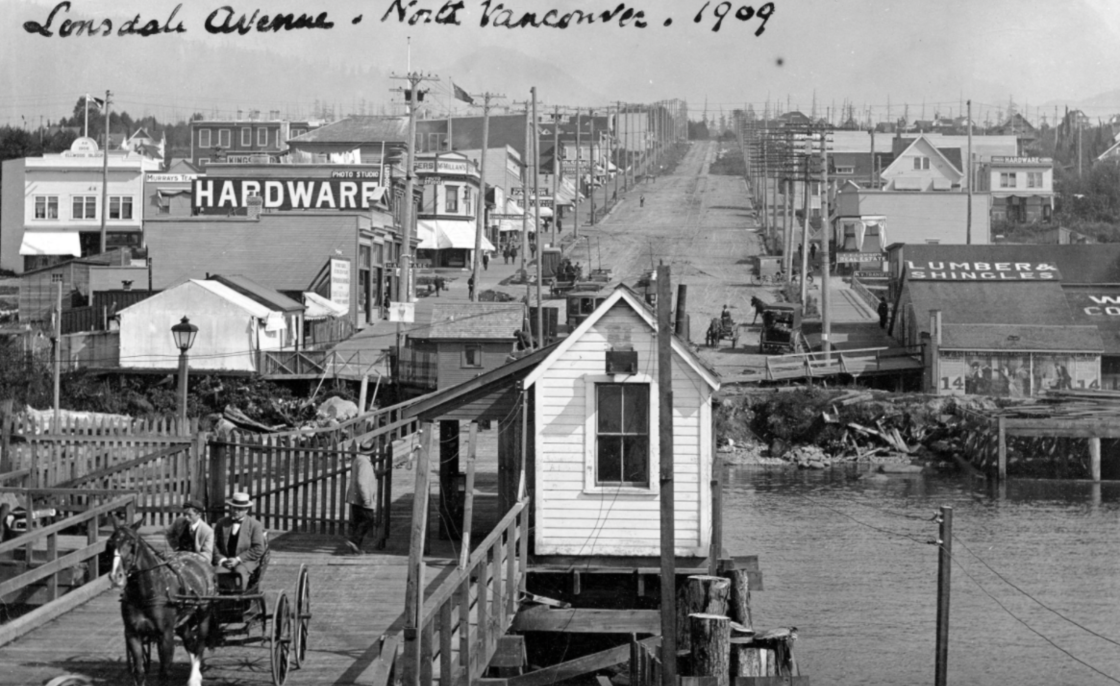In this article, we explore the history of the City of North Vancouver waterfront communities of Lower Lonsdale and Moodyville. We will be running an ongoing series of local history and landmarks to checkout while also covering current events and lifestyle.
History of Lower Lonsdale
Lower Lonsdale is a vibrant neighborhood located in the city of North Vancouver, British Columbia, Canada. The area has a rich history that dates back centuries, and it has played an important role in the development of the North Shore and Greater Vancouver region.
Indigenous History: The Lower Lonsdale area has been inhabited for thousands of years by Indigenous peoples, particularly the Squamish Nation. The area was known as X̱wemelch’stn (Homulchesan), which means “place of birch bark canoes,” due to the fact that the Squamish people built their canoes using birch bark found in the area. The Squamish people used the North Shore mountains for hunting, fishing, and gathering, and the Lower Lonsdale area was an important trading hub for the coastal Indigenous peoples.
Early Settlement: The first European settlement in the Lower Lonsdale area began in the mid-19th century. In 1862, Edward Stamp, a Scottish businessman, purchased a large tract of land in the area and established a sawmill. This marked the beginning of the industrialization of the area, and more mills and businesses followed.
In 1871, the government of British Columbia decided to move its capital from New Westminster to Victoria. As a result, the North Shore became an important transportation hub for goods and people traveling between Vancouver and Victoria. The Lower Lonsdale area became a major transportation center with the construction of the Pacific Great Eastern Railway in 1910 and the opening of the Second Narrows Bridge in 1925.
Development: The Lower Lonsdale area continued to grow and develop throughout the 20th century. In the 1950s and 1960s, many new high-rise apartment buildings were constructed, and the area became a popular destination for young families and retirees. In the 1980s, the City of North Vancouver initiated a major redevelopment plan for the area, which included the construction of new buildings, parks, and public spaces.
In recent years, Lower Lonsdale has become one of the most popular neighborhoods in North Vancouver. The area is home to a thriving arts and cultural scene, with numerous galleries, theaters, and music venues. There are also many excellent restaurants, cafes, and bars, as well as a thriving shopping district.
Today: Lower Lonsdale continues to evolve and grow, with new developments and projects in the works. One of the most significant projects is the redevelopment of the Lower Lonsdale waterfront, which will include new public spaces, parks, and commercial buildings. The area remains an important transportation hub, with easy access to the SeaBus, which connects North Vancouver to downtown Vancouver.
Lower Lonsdale has a rich and fascinating history that reflects the growth and development of the North Shore and Greater Vancouver region. The area has evolved from a small Indigenous trading post to a major transportation hub and thriving urban neighborhood. Its unique blend of history, culture, and modern amenities make it a beloved destination for locals and visitors alike.

History of Moodyville
Moodyville is a historic neighborhood located in the city of North Vancouver, British Columbia, Canada. The area has a rich history that dates back to the mid-19th century, and it played an important role in the development of the North Shore and Greater Vancouver region.
Early Settlement: The first European settlement in the Moodyville area began in 1863, when Sewell Prescott Moody, a New Westminster pioneer, established a sawmill on the shores of Burrard Inlet. The sawmill quickly became the economic engine of the area, and more businesses and industries followed.
In 1865, Moody built a small community near the sawmill, which he named Moodyville. The community included a general store, post office, school, and church, and it quickly became the center of commerce and social life in the area.
Growth and Development: Moodyville continued to grow and develop throughout the latter half of the 19th century. The community became an important transportation hub, with regular steamship service to Vancouver and other points along the coast. The Moodyville sawmill was also one of the largest employers in the area, providing jobs for hundreds of workers.
In the early 20th century, the Moodyville area experienced significant growth and development. Many new homes were constructed, and the community became a popular destination for young families and retirees. The area also became an important industrial center, with several new factories and mills opening in the area.
Decline and Renewal: The Moodyville area began to decline in the mid-20th century, as the sawmill and other industries began to close or relocate. Many of the area’s historic buildings were demolished or fell into disrepair, and the community’s population dwindled.
In the late 20th century, the City of North Vancouver initiated a major revitalization effort for the Moodyville area. The city invested in new infrastructure, parks, and public spaces, and the area became an attractive destination for developers and investors. Today, the Moodyville area is a thriving urban neighborhood with a rich history and a bright future.
Moodyville is an important part of North Vancouver’s history and a testament to the resilience and adaptability of the community. The area’s sawmill and other industries played a vital role in the development of the North Shore and Greater Vancouver region, and its history is preserved through its many historic buildings and landmarks.
And just for fun, a list of all mayors since the City was incorporated in 1907:
W. Angus McLean (1907-1908)
George William Rae (1909-1911)
James Cooper Keith (1912-1913)
Charles Frederick Platt (1914-1915)
William Joseph Bowser (1916-1917)
Andrew Alexander Dinwoodie (1918-1919)
Samuel Augustus Skinner (1920-1922)
George Ross Wilson (1923-1924)
George William Rae (1925-1926)
William Charles Rickard (1927-1928)
Harold St. John (1929-1930)
Samuel Augustus Skinner (1931-1934)
Edwin Oswald (1935-1944)
George Clyde Westwood (1945-1946)
George Rutherford (1947-1948)
Thomas Eugene Cook (1949-1950)
George William Pearkes (1951-1953)
Thomas Eugene Cook (1954-1955)
Fred E. Leith (1956-1957)
Harry Jerome (1958-1972)
Bill Angus (1973-1984)
Pat McGeer (1984-1986)
Don Bell (1987-1990)
Barbara Sharp (1990-1993)
Dave Durrie (1993-2002)
Ernie Crist (2002-2005)
Darrell Mussatto (2005-2018)
Linda Buchanan (2018-present)


